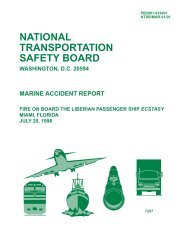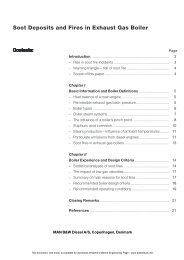Fuel Cells - Green Power - Martin's Marine Engineering Page
Fuel Cells - Green Power - Martin's Marine Engineering Page
Fuel Cells - Green Power - Martin's Marine Engineering Page
- No tags were found...
You also want an ePaper? Increase the reach of your titles
YUMPU automatically turns print PDFs into web optimized ePapers that Google loves.
The ElectrodesAll electrochemical reactions consist of two separate reactions: an oxidation half-reaction occurring at the anode anda reduction half-reaction occurring at the cathode. The anode and the cathode are separated from each other by theelectrolyte, the membrane.In the oxidation half-reaction, gaseous hydrogen produces hydrogen ions, which travel through the ionically conductingmembrane to the cathode, and electrons which travel through an external circuit to the cathode. In thereduction half-reaction, oxygen, supplied from air flowing past the cathode, combines with these hydrogen ions andelectrons to form water and excess heat. These two half-reactions would normally occur very slowly at the lowoperating temperature, typically 80˚C, of the polymer electrolyte membrane fuel cell. Thus, catalysts are used onboth the anode and cathode to increase the rates of each half-reaction. The catalyst that works the best on eachelectrode is platinum, a very expensive material.The final products of the overall cell reaction are electric power, water, and excess heat. Cooling is required, in fact,to maintain the temperature of a fuel cell stack at about 80˚C. At this temperature, the product water produced atthe cathode is both liquid and vapor. This product water is carried out of the fuel cell by the air flow.Definitions:Catalyst: A substance thatparticipates in a reaction,increasing its rate, but is notconsumed in the reaction.Current: The flow of electric chargethrough a circuit.Electrode: An electronic conductorthrough which electrons areexchanged with the chemicalreactants in an electrochemical cell.Electron: An elementary particlehaving a negative charge.1 nanometer: = 10 -9 m = 10 -7 cm= 10 -6 mm = 10 -3 µm = 1 nmOxidation half reaction: A process inwhich a chemical species changes toanother species with a morepositive charge due to the releaseof one or more electrons. It canoccur only when combined with areduction half reaction.Reduction half reaction: A process inwhich a chemical species changesto another species with a lesspositive charge due to theaddition of one or more electrons.It can occur only when combinedwith an oxidation half reaction.Electrochemistry of <strong>Fuel</strong> <strong>Cells</strong>Oxidation half reaction 2H 2 ➔ 4H + + 4e -Reduction half reaction O 2 + 4H + + 4e - ➔ 2H 2 OCell reaction 2H 2 + O 2 ➔2H 2 OThe physical and electrochemical processes that occur at eachelectrode are quite complex. At the anode, hydrogen gas (H 2 )must diffuse through tortuous pathways until a platinum (Pt) particleis encountered. The Pt catalyzes the dissociation of the H 2 moleculeinto two hydrogen atoms (H) bonded to two neighboring Pt atoms.Only then can each H atom release an electron to form a hydrogen ion(H + ). Current flows in the circuit as these H + ions are conductedthrough the membrane to the cathode while the electrons pass fromthe anode to the outer circuit and then to the cathode.The reaction of one oxygen (O 2 ) molecule at the cathode is a 4electron reduction process (see above equation) which occurs in amulti-step sequence. Expensive Pt based catalysts seem to be theonly catalysts capable of generating high rates of O 2 reduction at therelatively low temperatures (~ 80˚C) at which polymer electrolytemembrane fuel cells operate. There is still uncertainty regarding themechanism of this complex process. The performance of the polymerelectrolyte membrane fuel cells is limited primarily by the slow rate ofthe O 2 reduction half reaction which is more than 100 times slowerthan the H 2 oxidation half reaction.This document, and more, is available for download at <strong>Martin's</strong> <strong>Marine</strong> <strong>Engineering</strong> <strong>Page</strong> - www.dieselduck.net

















